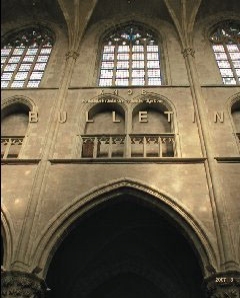Indexering ESCI / Scopus


Wim Denslagen: Architectuur en herinnering in de middeleeuwen. K.T. Meindersma: Een kloosterdeur uit Wargum. Merlijn Hurx: Middeleeuwse 'prefab' in de Nederlanden? De Hollandse kerken van de Antwerpse loodsmeester Evert Spoorwater. R. Meischke en H.J. Zantkuijl: De Delftse stadsbrand van 1536 en de verbreiding van booggevels. Dirk J. de Vries: Beproefde gevels.
How did people write about historical architecture in the MiddleAges? To what extent were they interested in ancient buildings? It is natural to assume that important buildings, for instance the great cathedrals, were also admired after the time of their realisation and that reports of this admiration have been preserved. However, such reports are probably rare. I do not know the reason of this, although I suppose that my research has not been sufficiently comprehensive.
It is likely that there is more to be found in the extensive literary heritage of the Middle Ages, but who has...
Sometime in the early 20th century the Groninger Museum acquired a primitively constructed door of an early date and presumably from Warffum. Recent research of the door revealed the identity of the building concerned, notably the ‘Johannietenklooster’ (monastery of the knights of St John) in the aforesaid village. The door is circular-arched and composed of two wide, thick oak parts and connected by means of two forged tail hinges.
With the passage of time the inside was completely clamped with pinewood parts. This fact could have been marked by the date 1586 and some other...
The first study, which touched upon the phenomenon of commercial gothic in the Netherlands, was carried out twenty years ago by the Dutch architectural historian Ruud Meischke. Meischke proposed that in the fifteenth century, as a consequence of high transportation costs and tolls, stones for building were increasingly cut into shape in the quarries in the southern Netherlands rather than at the building site.
At the end of the century major parts of churches were delivered as a kind of 'prefab' that could be assembled on the spot. Since Meischke published his challenging thesis...
Among the many large town fires in the 16th century the fire of Delft in 1536 was the most extensive. The extent of this disaster is to be compared to a large bombing during the last World War. A lot of the rebuilt houses still exist, some even with the old facades. Four drawings from around 1785 of disappeared facades complete the picture and gave rise to this article (ill. 4. 10-12).
After the fire the walls of churches and monasteries largely survived and the wooden roofs and vaults could be restored. The houses needed total renewal. There is not much evidence of guidance in...
The patron saint of the bricklayers' guild varied from town to town: St Barbara occurs regularly, but also the Four crowned ones (Antwerp and Dordrecht) and even St Joseph in case there was cooperation with the carpenters (Leiden). Throughout the Netherlands the history of these guilds dates back to the Middle Ages, but the oldest written regulations concerning the masterpiece were not drawn up until around the '40s of the 16th century.
Usually this period is not considered to be the Middle Ages anymore, because by that time the Renaissance dawned in the Low Countries. The new...


open access mogelijk gemaakt door Stichting OpenAccess
